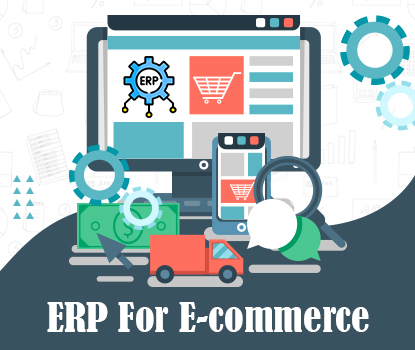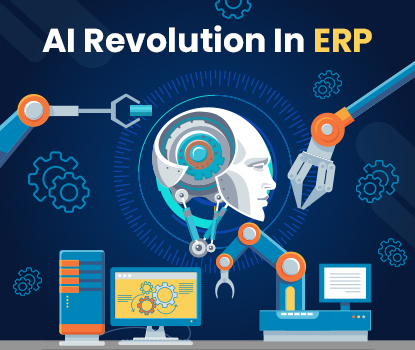Welcome to the world of Enterprise Resource Planning, where business optimization meets cutting-edge technology. In this comprehensive guide, we embark on a journey through the intricate landscape of ERP guide. Whether you're a seasoned business leader looking to refine your ERP strategy or a curious newcomer eager to understand the foundational principles, this guide is your compass.
We'll navigate through the fundamental concepts, explore the diverse modules and functionalities, and unveil the transformative power of ERP in modern enterprises. Join us as we delve deep into the details in this ERP guide, decode the jargon, and demystify the complexities of Enterprise Resource Planning. Together, we'll unravel how ERP systems drive operational excellence, enhance decision-making, and redefine the way businesses thrive in today's dynamic landscape.
What is ERP?
Enterprise Resource Planning (ERP) is a comprehensive software solution designed to streamline and integrate various business processes and functions within an organization. It enables efficient management and real-time sharing of critical data and information across different departments, from finance and human resources to manufacturing, supply chain management, sales, and customer service.
Types of ERP
Enterprise Resource Planning (ERP) systems come in various types to cater to the diverse needs of businesses. Here are some common types of ERP:
-
On-Premises ERP
On-premises ERP software is installed and hosted on the company's own servers and hardware. It offers complete control over the system but requires a significant initial investment in infrastructure and ongoing maintenance. Suitable for large organizations with specific security or compliance requirements.
-
Cloud-Based ERP
Cloud ERP solutions are hosted on the vendor's servers and accessed via the internet. They are popular for their flexibility, scalability, and lower upfront costs since they follow a subscription-based pricing model. Cloud ERP systems also offer remote access and automatic updates. Ideal for businesses looking for agility, scalability, and cost-effectiveness.
-
Open-Source ERP
Open-source ERP software provides access to the source code, allowing businesses to customize the system to their specific needs. While it offers great flexibility, it may require more technical expertise for setup and maintenance. Suited for organizations seeking a high degree of customization and willing to invest in development.
-
Industry-Specific ERP
Some ERP solutions are tailored for specific industries, such as manufacturing, healthcare, or retail. They come pre-configured with features and modules relevant to that industry, making implementation quicker and more effective. Ideal for businesses in niche industries with unique requirements.
-
Small Business ERP
These ERP systems are designed specifically for small and medium-sized enterprises (SMEs). They offer essential features at a lower cost, making them more accessible to smaller businesses. Suited for startups and small businesses looking to streamline their operations.
-
Mid-Market ERP
Mid-market ERP solutions are aimed at medium-sized businesses that need more advanced features than small business ERP systems but don't require the complexity of an enterprise-level solution. Ideal for growing businesses that need scalability and more comprehensive functionality.
-
Enterprise ERP
Enterprise-level ERP software is designed for large corporations with complex operations. It offers extensive customization, scalability, and can handle multiple locations, currencies, and languages. Suited for large enterprises with global operations and diverse needs.
-
Two-Tier ERP
In this setup, a large organization uses two ERP systems: one at the corporate level (often an enterprise ERP) to manage overarching processes and another at the subsidiary or division level (often a smaller ERP) to handle specific operations unique to that unit. Commonly used by multinational corporations with different divisions or business units.
-
Mobile ERP
These ERP systems are designed to be accessible and functional on mobile devices, making it convenient for employees who are on the go or working remotely. Suited for businesses with a mobile workforce or those that prioritize mobile accessibility.
-
Hybrid ERP
Hybrid ERP solutions combine elements of on-premises and cloud-based systems. They allow businesses to keep some data on their premises for security reasons while leveraging the benefits of the cloud for other data and processes. Ideal for organizations with specific security or compliance needs.
Examples of ERP
Enterprise Resource Planning (ERP) software is widely used across various industries and sectors to streamline business operations. Here are some examples of ERP systems and the industries they cater to:
-
SAP ERP
SAP is one of the largest and most well-known ERP providers globally. It offers a range of ERP solutions tailored to specific industries, including SAP S/4HANA for manufacturing, SAP Business One for small businesses, and SAP ERP for large enterprises.
-
Oracle ERP Cloud
Oracle provides cloud-based ERP solutions that cover financials, procurement, project management, and more. It serves industries like manufacturing, retail, healthcare, and hospitality.
-
Microsoft Dynamics 365
Microsoft's ERP offering includes Dynamics 365 Finance, Supply Chain Management, and Business Central. These solutions cater to various industries, including manufacturing, distribution, retail, and services.
-
NetSuite
NetSuite, now owned by Oracle, is a cloud-based ERP system known for its scalability and versatility. It serves businesses across industries such as e-commerce, manufacturing, software, and services.
-
BrainCave 360 ERP
BrainCave 360 ERP is a unique and personalized ERP solution present in the market for different types of businesses in the global industry.
Benefits of ERP
Enterprise Resource Planning (ERP) systems offer a wide range of benefits to businesses across various industries. Here's a breakdown of these benefits, supported by relevant statistics:
-
Streamlined Business Processes
ERP software integrates and automates core business processes, reducing manual data entry and improving efficiency. According to Panorama Consulting Solutions, 95% of organizations saw improvements in some or all of their business processes after ERP implementation.
-
Improved Data Accuracy
ERP systems provide a single source of truth for data, reducing errors and ensuring data accuracy. Gartner predicts that by 2022, 30% of manual data tasks will be automated, leading to a 50% reduction in data entry errors.
-
Enhanced Reporting & Analytics
ERP software offers robust reporting and analytics capabilities, providing insights to make informed decisions. Aberdeen Group found that organizations with ERP solutions are 2.2 times more likely to have real-time visibility into their processes.
-
Improved Customer Service
ERP systems enable better customer relationship management by providing a 360-degree view of customer interactions. According to Salesforce, 70% of customers say connected processes, like seamless handoffs or contextualized engagement based on earlier interactions, are very important to winning their business.
-
Cost Savings
ERP systems reduce operational costs by optimizing processes and reducing manual labor. Nucleus Research reports that for every dollar spent on ERP, businesses can expect an average return of $7.23.
-
Inventory Management
ERP software helps optimize inventory levels, reducing carrying costs and minimizing overstocking or understocking. According to Statista, 48% of businesses using ERP solutions cite inventory management as one of the top areas where they've experienced improvements.
-
Better Supply Chain Management
ERP systems improve supply chain visibility, coordination, and efficiency. The Aberdeen Group found that organizations with ERP are 2.3 times more likely to have real-time visibility into the status of all their suppliers.
-
Increased Productivity
ERP automates routine tasks, allowing employees to focus on higher-value activities. According to a report by Panorama Consulting, ERP systems lead to a 20-30% reduction in overall working hours.
-
Scalability
ERP solutions are scalable, adapting to the changing needs of businesses as they grow. Aberdeen Group reports that 96% of Best-in-Class organizations believe that the ability to scale is important or very important.
-
Compliance & Security
ERP systems help organizations adhere to regulatory compliance standards and enhance data security. A survey by Protiviti found that 89% of organizations view compliance with data protection laws as a top priority.
Conclusion
In conclusion, ERP guide (Enterprise Resource Planning) is the compass for modern businesses, orchestrating the harmony of processes, data, and efficiency. This comprehensive guide has illuminated the intricate world of ERP, from its fundamental principles to the diverse types and real-world examples that cater to various industries.
The benefits of ERP systems are undeniable, driving streamlined operations, enhanced data accuracy, improved customer service, substantial cost savings, and much more. As businesses continue to evolve in a dynamic landscape, ERP remains a vital tool for staying competitive and adaptable.
Our journey through this ERP guide has demystified the complexities of these systems, empowering both seasoned leaders and newcomers with the knowledge to navigate the ever-changing currents of the business world. With ERP guide as your ally, your enterprise can thrive, innovate, and reach new heights of operational excellence.




